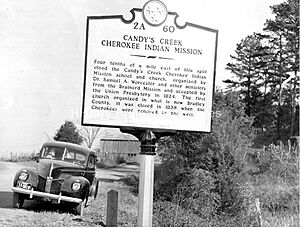Candies Creek Ridge facts for kids
Candies Creek Ridge, also known as Clingan Ridge, is a natural landform called a ridge. It's mostly found in Bradley County, Tennessee, near the southeastern border of the state. This ridge looks over Candies Creek and is located north of Cleveland, Tennessee.
In 1996, a large village from the ancient South Appalachian Mississippian culture was discovered here. This village was built around 1000 to 1200 CE. It was quite unusual to find such a village in this spot, because Mississippian villages were usually built in low-lying areas along rivers and creeks. The 5-acre site was bought by The Archeological Conservancy in 2001 to protect it. Today, it is known as the Jim Sharp Archeological Preserve.
Contents
What is Candies Creek Ridge?
This ridge is part of a series of parallel ridges that are connected to the Ridge-and-Valley section of the Appalachian Mountains. Candies Creek Ridge is one of the tallest in this area. It averages about 997 feet (304 meters) high. The highest point, located in Cleveland, Tennessee, reaches 1,014 feet (309 meters). South of Cleveland, it's also called Lebanon Ridge. The ridge stretches from Tunnel Hill, Georgia all the way to the lower Hiwassee River at the border between Bradley and McMinn County in Tennessee.
Many roads cross this ridge. These include (from south to north) GA SR 2, TN SR 317, APD-40, US 11/US 64, SR 312, Interstate 75 and SR 60 (together), Paul Huff Parkway, and SR 308.
To the west of Candies Creek Ridge is another ridge, usually called Mount Zion Ridge in Tennessee. In the valley between these two ridges is Candies Creek. To the east, in northern Bradley County, is Mouse Creek Ridge. The valley between them holds South Mouse Creek. This eastern ridge is known as Lead Mine Ridge in southern Bradley County and in Georgia.
History of the Ridge
For thousands of years, this area was home to many different indigenous peoples (native cultures). This was common throughout the river and creek valleys in the Southeast.
In 1996, a team of archeologists was asked to check for possible Cherokee graves. This was happening at a new housing development site a few miles west of Candies Creek Ridge. Instead, they found a large village from the ancient South Appalachian Mississippian culture. This village has been dated to between 1000 and 1200 CE. The remains of buildings showed that it had a defensive palisade, which is a strong fence made of tall wooden stakes. Archeologists found it unusual to discover such a large Mississippian site in the uplands (higher ground). These villages were typically built in the low-lying areas along rivers.
The Archeological Conservancy bought the site from the developer. The developer sold it for less than its market value because they understood its historical importance. Both the Eastern Band of Cherokee Indians and the Cherokee Nation approved this sale. More work at the site has uncovered many different artifacts, another Mississippian palisade, some human burials, and trade goods linked to the historic Cherokee people. After studying and mapping the area, researchers left most of the findings undisturbed in the ground. This allows for future studies. The federally recognized Cherokee tribes arranged for the human burials to be re-honored. The site is now called the Jim Sharp Archeological Preserve, named after the man who sold the land to the Conservancy.
The historic Cherokee people called the creek in the valley west of the ridge in Bradley County "Little Kiuka Creek." Their nearby village was located where two creeks met.
From the 1800s to Today
Later, European Americans named the waterway Candy's Creek (now Candies Creek). This was in honor of Henry Candy, who settled along the creek around 1817. This happened after the Cherokee had given up their land north of the Hiwassee River to the United States.
The Candy's Creek Cherokee Indian Mission Station was started in 1824 by Samuel Worcester and five other people. It was built near the historic Cherokee village by the creek. Today, the intersection of SR 60 and Paul Huff Parkway is south of where this station used to be. The station closed in 1838 after the Cherokee Removal, when many Cherokee people were forced to move. This mission station was important because it was the first organized church and post office in Bradley County. The building also had a school.
A historical marker remembering the mission station was put up near the historic site along SR 60 in 1959. It was near the present-day intersection of Paul Huff Parkway. This marker disappeared, reportedly around the time Paul Huff Parkway was built. Candy's Creek Cherokee Elementary, a new school in North Cleveland, opened in August 2019. It was named after the mission station.
In Bradley County, the ridge is named for the Clingan family. They lived on the ridge in what is now northern Cleveland. A.A. Clingan, a member of this family, was Bradley County's first elected sheriff. He served from 1837 to 1838 and again from 1840 to 1846. His wife, Martha Blythe, came from the family that started Blythe Ferry in 1809. This ferry was on the south side of the Tennessee River in Meigs County, Tennessee. The Clingan family cemetery, located at the western base of the ridge off SR 60, was found again in 2014 and restored in 2016.
Counties Where the Ridge is Found
- In Georgia
- In Tennessee
Cities and Towns Near the Ridge


